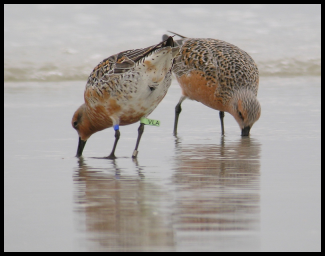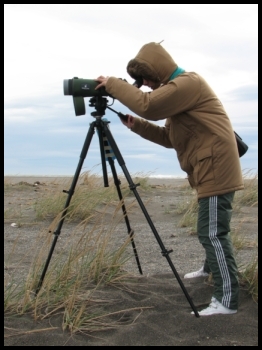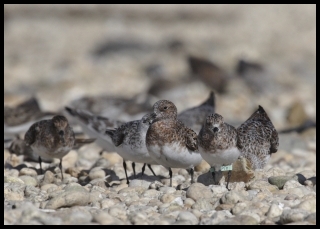What to Report
Good: Your name and e-mail address, date, time, location, species and flag color and inscription. For example “flag lime (VLA)“
Better: The above plus the rest of the band combination. For example “Blue / -: Flag lime (VLA)/ metal” which denotes a blue band on the upper left, nothing on the lower left, a flag on the upper right and a metal on the lower right.
Super: The above plus: tide stage, how well the flag was seen, how many of that species were there, what the birds were doing, which (and how many) other birds were there also.
Best: The above plus a photo.
Recommended Equipment and Techniques
 With a great scope, such as a Swarovski or Leica, and a heavy tripod, you can read flag letters and numbers more than 50 yards away. In poor light or with other equipment you will need to get closer. Use cover and stealth, angle slowly toward the birds and bepatient. The flock initially may spook easily, but they will get used to you. It’s helpful to approach them on consecutive days.
With a great scope, such as a Swarovski or Leica, and a heavy tripod, you can read flag letters and numbers more than 50 yards away. In poor light or with other equipment you will need to get closer. Use cover and stealth, angle slowly toward the birds and bepatient. The flock initially may spook easily, but they will get used to you. It’s helpful to approach them on consecutive days.
Where & When
Birds that are feeding hungrily are easiest to approach, so best times are falling tides when their food isfirst exposed. Often they will have favorite "hot spots" that they visit each day (don't forget the tide changes 45 minutes later each day). Red knots often feed on shellfish buried in sand, so look along ocean beaches, on sandy spits, especially at the points either side of ocean inlets. Sanderlings will be along the ocean surf, and  turnstones at rocky jetties or at marinas. Banded semipalmated sandpipers will be in muddy areas in back bays. American oystercatchers frequent the edge of marshes in back bays, or on the back/ bay side of ocean inlets; listen for them calling in flight.
turnstones at rocky jetties or at marinas. Banded semipalmated sandpipers will be in muddy areas in back bays. American oystercatchers frequent the edge of marshes in back bays, or on the back/ bay side of ocean inlets; listen for them calling in flight.
After feeding, shorebirds will often roost in tight flocks near the feeding area.
For best sightings, calm days and low sun at your back are optimum.